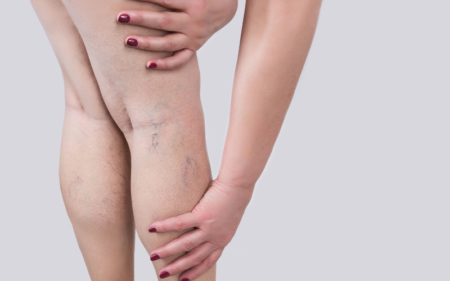
Did you know that spider veins aren't actually veins?
They're damaged capillaries, venules, or arterioles. Capillaries are the smallest blood vessels in the body, and they connect the arterioles (small arteries) to the venules (small veins).
Because they are so small, they can reach almost every cell in the body and help move nutrients, oxygen, and waste between the blood and the cells.
We reference the word “spider” because spider veins closely resemble a spider's web. Let’s dive into how we can monitor and treat this condition at home.
Spider veins are small damaged vessels that lie below the skin’s surface. They appear red, blue, or purple, are not typically painful, and don’t bulge.
Varicose veins are larger, bulging, and often painful. Unlike spider veins, varicose veins are veins.
Spider veins are usually harmless and nothing more than a cosmetic issue, but sometimes they can cause burning, itching, pain, and cramping. Occasionally, they’re an early sign of chronic venous insufficiency (CVI), which can affect health and quality of life over time.
Prevention and prompt intervention are key to minimizing the negative impacts. Exercise and maintaining a healthy weight improve circulation while reducing vascular pressure. A vein specialist may recommend compression therapy before medical treatment.
If pain or cosmetic issues continue, you’ll likely need medical treatment. Laser ablation and sclerotherapy are in-office treatments providing phenomenal results.
More than 50% of women under 80 have spider veins. Genetics, lifestyle, hormones, and age contribute to the weakening of vessels. As the vessel walls weaken, pooling in the veins results.
In general, here are some of the many risk factors associated with spider veins:
Treatment for spider veins ranges from lifestyle changes to surgical intervention. This article will focus on at-home prevention and treatment for spider veins.
When people hear the “E” word from the provider, they roll their eyes. But, because regular exercise has so many benefits, it is worth considering.
People assume that to get credit for exercising, they have to be able to run a marathon. This is a myth.
If you have a desk job, do toe/heel taps or leg lifts while sitting, and alternate positions if your occupation has you standing for a long time. Low-impact exercises — like swimming, biking, or walking — count toward accomplishing the “E” word.
The goal is to get the blood pumping, so pick exercises that you’ll enjoy.
A healthy weight decreases strain on the whole body, including veins. A diet high in processed, sugar-loaded foods contributes to poor circulation, hormonal imbalances, and increased blood pressure. These factors damage blood vessels.
Food has the power to heal. A diet high in fiber improves heart health and decreases inflammation in the body.
Fruits and vegetables are high-fiber foods that help prevent constipation and bloating, which is why you should try to eat one fruit and vegetable each meal. Fish is a nutrient-dense food that decreases inflammation and helps with spider veins.
Compression stockings help support the blood vessels, which improves circulation and prevents pooling. Your provider will instruct you on how often or long to wear them.
Remember to get the right size, because it defeats the purpose if the elastic band is too tight.
Many swear that certain essential oils and supplements have helped their spider veins, while others see no benefits. If using essential oils, choose the therapeutic grade for the best results.
Talk to your doctor about supplements before using them. Certain supplements can negatively interact with prescription medications.
Avoid sitting or standing for long periods. Elevating your legs also supports blood flow. Steer clear of clothes with tight-fitting bands, as these bands restrict circulation.
These home remedies are holistic and support overall health. They are simple and inexpensive. Yet, they have their limitations.
Home remedies don’t always get the desired results. Speak to a vein specialist to determine your best course of action.
Laser ablation and sclerotherapy are two minimally-invasive outpatient procedures. They have proven to be effective for decades. Your specialist at Center for Vein Restoration will review all recommended treatment options and guide you every step of the way to achieving healthier legs!
Consider medical treatment when home remedies are ineffective. Talk to a vein specialist if you are ready to eliminate spider veins.
Medical treatment efficiently reduces the appearance of spider veins. Laser ablation and sclerotherapy allow you to return to your normal activities with few restrictions. Both effectively and efficiently treat spider veins, but they have some risks.
Home remedies are not always effective. Yet, improving your overall health has benefits that far outreach spider vein treatment.
As with most home remedies, they usually take time to determine effectiveness. You can expect a few weeks of faithful application before seeing results. However, they are inexpensive and worth trying — especially if your spider veins are mild.
Medical treatment provides immediate results. Laser ablation and sclerotherapy offer efficient treatment without harsh side effects.
Home remedies may be inexpensive, but sometimes, they aren’t practical. The cost of medical treatments varies depending on the size and location of the affected area. Sclerotherapy is most often used to treat spider veins because it’s proven to eliminate the targeted veins permanently.
The best home remedies get the blood pumping and decrease strain on the body. Low-impact exercises, an anti-inflammatory diet, and compression therapy prevent and improve spider veins.
Center for Vein Restoration can help you every step of the way. Whether you’re just learning about vein treatments or suffering from varicose veins, we’re here to help. We are led by doctors, and inspired by patients.
It’s important to remember to be patient and consistent when using home remedies. If home remedies are ineffective or spider veins are affecting your confidence, don’t wait. Talk to a vein specialist today to see what options are available for you.